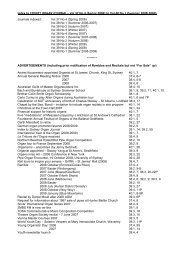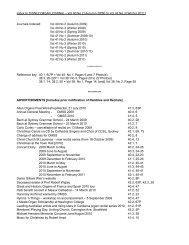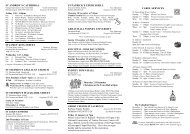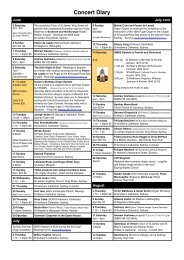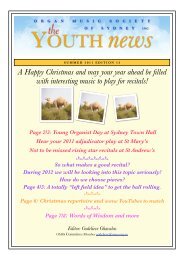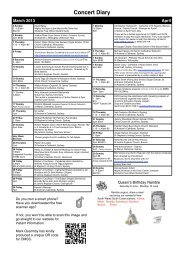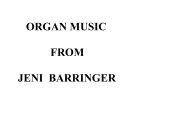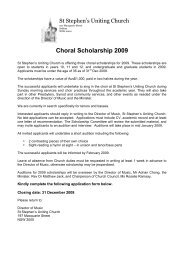Ashfield Organ Mystery Deepens - The Organ Music Society of Sydney
Ashfield Organ Mystery Deepens - The Organ Music Society of Sydney
Ashfield Organ Mystery Deepens - The Organ Music Society of Sydney
You also want an ePaper? Increase the reach of your titles
YUMPU automatically turns print PDFs into web optimized ePapers that Google loves.
A Century <strong>of</strong> <strong>Organ</strong> <strong>Music</strong> at St. John’s, <strong>Ashfield</strong><br />
A historical account <strong>of</strong> the music <strong>of</strong> the Parish<br />
in connection with the <strong>Organ</strong> Dedication Festival 1950.<br />
(written by F.A.S. Shaw, Rector and K.A. Noake, <strong>Organ</strong>ist & Choirmaster)<br />
<strong>Organ</strong>s have made a real contribution to the beauty <strong>of</strong> St.<br />
John’s services for one hundred and five years. <strong>The</strong> first<br />
instrument was a keyboard reed organ known as a seraphine,<br />
presented by the Bishop’s registrar, which served from the<br />
consecration in 1845 for a short time. Its place was taken by a<br />
harmonium later, which did duty until the advent <strong>of</strong> Dr.<br />
Corlette in 1867. Under his rectorship, Mr. Davidson <strong>of</strong><br />
<strong>Sydney</strong> erected a pipe organ in the western gallery in 1871,<br />
where the choir sat grouped about it. This was a very good<br />
instrument, sweet toned, with one manual and pedal organ. It<br />
is, incidentally, still giving yeoman service at St.<br />
Bartholomew’s church, Pyrmont to whom it was sold in 1882.<br />
Its stop specification was as follows:<br />
Great: Open Diapason 8, Duliciana 8, Stopped Diapason 8,<br />
Principal 4, Flute 4, Fifteenth 2 (last five enclosed).<br />
Pedal: Bourdon 16. Great to pedal<br />
St John’s, <strong>Ashfield</strong> Rector, the Revd Canon Dr J.C. Corlette<br />
In 1875 the then existing building was enlarged by the<br />
addition <strong>of</strong> transepts and chancel, making the interior the size<br />
it is today. <strong>The</strong> little organ was found inadequate for the<br />
church and in 1881 Dr. Corlette commenced operations for the<br />
improvement <strong>of</strong> the situation. After much discussion, it was<br />
decided to commission Messrs. Hill <strong>of</strong> London to build a<br />
completely new two manual and pedal organ. In this step, we<br />
<strong>of</strong> the present fervently applaud the wisdom and foresight <strong>of</strong><br />
Dr. Corlette. At this period, Hill and Son was one <strong>of</strong> the<br />
foremost organ building firms in the world, completing at the<br />
time instruments for St. Andrew’s Cathedral, <strong>Sydney</strong> (old<br />
organ), <strong>Sydney</strong> Town Hall (when built, the biggest in the<br />
world) as well as many other notable instruments in England<br />
and Australia. It was eventually decided to place the new<br />
organ in its present position in the north transept, with the<br />
console built in across the corner. Dr. Corlette was most<br />
meticulous in his planning, and was determined that the<br />
church should have the noblest organ that funds would allow.<br />
He and a Mr. Harrison drew up the stop specification which<br />
was as follows:<br />
Pedal organ Great organ Swell organ<br />
Open Diapason 16 Open Diapason 8 Bourdon 16<br />
Bourdon 16* Dulciana 8 Open Diapason 8<br />
Stopped Diapason 8 Pierced Gamba 8<br />
Violoncello 8 Principal 4 Principal 4<br />
Great to Pedal Flute 4 Flautina 2<br />
Swell to Pedal Fifteenth 2 Bright mixture III ranks<br />
Swell to Great Oboe 8<br />
Composition pedals: 3 to Swell; 2 to Great.<br />
*“Voiced like a violin”<br />
<strong>The</strong> price was “not to exceed four hundred pounds in<br />
London” (a study in the times, then and now!). When the<br />
contract was finally signed, Dr. Corlette sent a letter to Hill,<br />
exhorting him in somewhat whip-cracking terms, to build, as it<br />
were, a masterpiece. He did, in fact, put the firm on its mettle.<br />
<strong>The</strong> organ was finally installed in 1885 with the stop<br />
specification somewhat altered. <strong>The</strong> pedal Diapason had,<br />
most unfortunately, to be omitted because <strong>of</strong> lack <strong>of</strong> space, and<br />
the “Bright Mixture” was reduced from three ranks to two.<br />
<strong>The</strong> 16ft. Bourdon was omitted from the Swell, also. A little<br />
time after the installation, a Gedackt and Celestes were added<br />
to the Swell. <strong>The</strong> specification now became as it has been<br />
over the years.<br />
<strong>The</strong> Hill organ in its original state served nobly over a period<br />
<strong>of</strong> some sixty-five years, but about 1945, the present organist,<br />
realizing that the instrument badly needed rebuilding,<br />
inaugurated an “<strong>Organ</strong> Rebuilding Fund.” <strong>The</strong> pedal board




